Michelangelo
Buonarroti
1475-1564
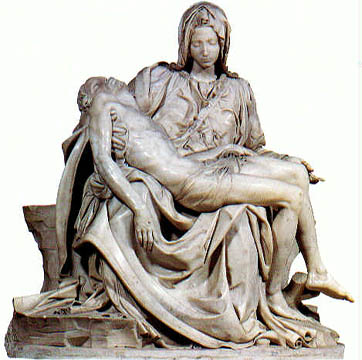
Pieta
St. Peter's, Rome 1500
Unlike Leonardo, Michelangelo
was of noble birth. His father, Ludovico di Buonarotti, sent his son to
be raised by a stone carver and his wife, since his mother was too ill to
nurse him. It was because of this arrangement that the young boy learned
to carve. Michelangelo later wrote, "When I told my father that I wished
to be an artist, he flew into a rage, saying that 'artists are laborers,
no better than shoemakers.' " His father wanted him to be a man of letters,
a scholar of higher learning. When Michelangelo finally convinced him to
allow him to apprentice to be an artist, his talent emerged in very little
time. He went on to study at the sculpture school in the Medici gardens,
and when Lorenzo de Medici recognized his talent, was invited live in the
Medici household. In this environment, he was introduced to the great humanist
thinkers of the day, who were frequent visitors to the Medici court. He
would soon travel to Rome, witnessing the great marble statues that would
have a lasting impact on his art.
One of first
sculptures Michelangelo created upon his return from Rome was the Pieta.
It is one of his most famous works, finished before Michelangelo was
25 years old. The youthful Mary is shown seated majestically, holding
the dead Christ across her lap, a theme borrowed from northern European
art (see Gothic Pieta at right, circa early 14th century).
Instead of revealing extreme grief, Michelangelo's Mary is restrained,
and her expression is one of resignation. The theme was a compositional
challenge, as previous versions of the same subject always looked awkward,
with the dead Jesus practically falling off of Mary's lap. Michelangelo
adjusted the composition by enlarging Mary's figure. We fail to notice
her size because we are distracted by the folds in her drapery, the
realistic portrayal of flesh and muscles, and its harmonious composition. |
|
Just days after it was placed
in Saint Peter's, Michelangelo overheard a visitor remark that the work
was done by another artist. That night Michelangelo sneaked into the Cathedral
and carved an inscription on the sash running across Mary's chestin: "Michelangelus
Bonarotis Florent Facibat" (Michelangelo Buonarroti, Florentine, made
this). This is the only work that Michelangelo ever signed. He later regretted
his passionate outburst of pride and determined to never again sign a work
of his hands.
See Details of Pieta
David:
Symbol for the
Liberty of Florence
Having secured his reputation
as one of Florence's greatest sculptors, Michelangelo won another commission
for an important project. The statue of David was meant to commemorate the
liberty of Florence, a republic which had recently won its independence. The
biblical youth who slays a giant becomes a symbol for their this liberty, demonstrating that inner
spiritual strength can prove to be more effective than arms. Unlike Donatello's earlier version of the same subject, Michelangelo's David
is pictured before the fight, gazing into the distance at his opponent. Since
Goliath is not present, the story can be perceived in David's intense gaze,
as well as in his powerful hands. His left hand holds a slingshot, and his
right holds a rock. Carved
from an 18 ft. tall block of marble which had been abandoned by an earlier
sculptor, the finished size is over 14 feet tall. David is represented as an athletic, manly character, very concentrated and
ready to fight. Though his body appears to be relaxed (emulating the contrapposto
pose of classical Greek sculpture), the tension of the conflict is evident
in his worried look. In his writings, Michelangelo describes his warrior-hero:
"Eyes watchful...the neck of a bull...hands of a killer...the body, a
reservoir of energy. He stands poised to strike."
.
The
Sistine Chapel Ceiling
The Vatican, Rome (1508-1512)

An Overview of the Ceiling
|
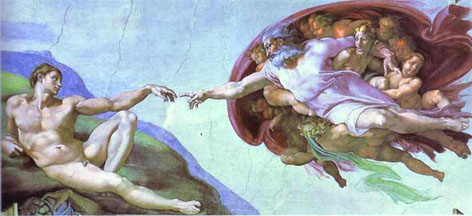
The Creation of Adam
By far the most
famous section of the Sistine Chapel Ceiling, Michelangelo depicts
Adam in his full physical form. The act of creation is in the touch
of the Creator's hand with that of Adam's. Behind God is the image
of Eve, as yet unborn, and other figures representing their descendents.
The child, which God touches with his other hand, probably refers
to the later birth of Christ.
|
Michelangelo was
commissioned by Pope Julius II to repaint the ceiling of the Sistine Chapel
after removing him from another project which Michelangelo was concentrated
upon finishing, that of Pope Julius' tomb. At first, Buonarroti tried to turn
down the commission, stating that he was a sculptor and not a painter. The
pope, however, was insistent. Despite his initial reluctance, the sculptor's
plans far exceeded the original order of 12 painted figures on the 44 x 128
foot ceiling. When he finished the painting four years later, he had painted
over 300 figures. Working high above the chapel floor, on scaffolding, these
are some of the greatest images of all time. On the vault of the papal chapel,
he devised an intricate system of decoration that included nine scenes from
the Book of Genesis, beginning with God Separating Light from Darkness and
including the Creation of Adam and Eve, the Temptation and Fall of Adam and
Eve, and the Flood. These centrally located narratives are surrounded by alternating
images of prophets and sibyls on marble thrones, other Old Testament subjects,
and by the ancestors of Christ.
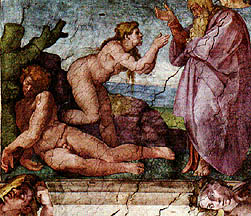
The Creation of Eve
|
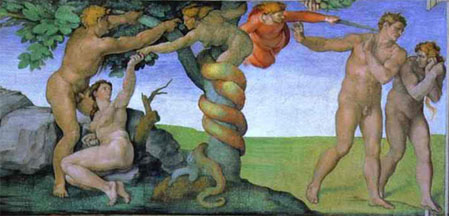
The Temptation and Expulsion
From Garden of Eden
|
Though the Creation of Adam is the most famous frieze from the Sistine ceiling, Michelangelo placed
the Creation of Eve at the exact center of the composition. The photo
at left was taken before the restoration of the ceiling. The Temptation and The Fall were in a similar state, with cracked plaster and colors
darkened by over 400 years of candle soot, until the frescos were recently
restored in the 1980s.
Michelangelo sketched all of
the images before the project of painting was begun. Some of these he altered.
Such is the case with the Libyan Sybil (a sybil is a female prophet,
or seer). The original cartoon shows that he studied the pose from a male
figure, but he decided to transform him into a female. This practice accounts
for the extremely muscular physique of his portrayal of women in general.
The photo at right shows a restorer working on this section of the painting.
One thing that is not evident in the central photo is the curved surface
on which it is painted. Michelangelo's mastery of perspective and forshortening
allows the viewer to see the figure at a distance without the distortion
that a lesser painter would have achieved.
The
Last Judgement
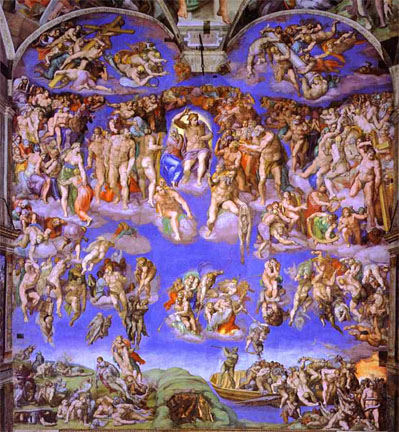
Central Theme of the Last Judgement
(Sistine Chapel Altar Wall)
Created 25 years after the ceiling,
the Last Judgement was painted on the altar wall of the Sistine chapel.
The face of religion has changed with the intervening years. With the Reformation
of the Church, the attitude of the imagery is more severe than that which
is depicted on the ceiling. With a clap of thunder, God puts into motion the
inevitable separation, with the saved ascending on the left side of the painting
and the damned descending on the right into hell. Michelangelo portrayed all
the figures nude, but prudish draperies were added by another artist a decade
later, as the cultural climate became more conservative. Even before its official
unveiling, the Judgment became the target of violent criticisms of
a moral character. Biagio da Cesena, the Vatican's master of Ceremonies, said
that "it was mostly disgraceful that in so sacred a place there should have
been depicted all those nude figures, exposing themselves so shamefully",
and that it was "no work for a papal chapel but rather for the public
baths and taverns." Michelangelo's revenge was to paint Biagio in hell, in
the figure of Minos, with a great serpent curled around his legs, among a
heap of devils. (He was no less kind to himself, however, for Michelangelo
painted his own image in the flayed skin of St. Bartholomew). Others accused
the painter of heresy. One official of the church even called for the fresco's
destruction, and a long statement of charges was drawn up against Michelangelo.
But the nudity of the figures didn't bother Pope Paul III nor his successor
Julius III. It was not until January 1564, and therefore about a month before
Michelangelo's death, that the assembly of the Council of Trent took the decision
to "amend" the fresco by adding draped cloth around the offending parts.
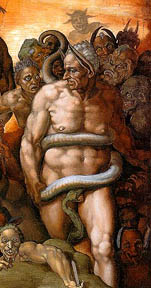
Detail of Baggio,
a critic of the mural
|
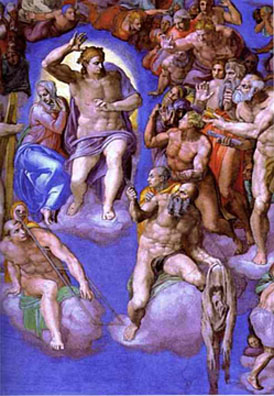 St. Bartholomew's Flayed Skin,
at right,
St. Bartholomew's Flayed Skin,
at right,
is possibly a self-portrait |
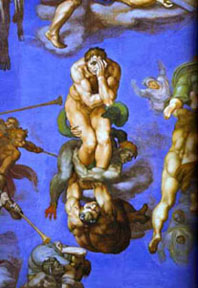
One of the "Damned",
also self-portrait?
|
The
Tomb of Pope Julius
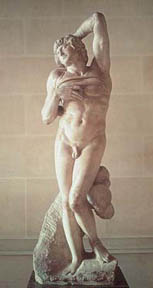
Dying Slave
|
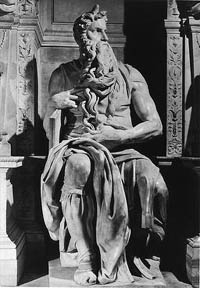
Moses
|
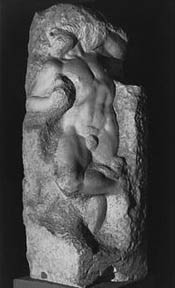
Captive Slave
|
Before the assignment of the Sistine Ceiling in 1505, Michelangelo had
been commissioned by Julius II to produce his tomb, which was to include
more than 40 figures. Due to a mounting shortage of money, however, the
pope ordered him to put aside the tomb project in favor of painting the
Sistine ceiling. When Michelangelo went back to work on the tomb, he redesigned
it on a much more modest scale. Nevertheless, Michelangelo made some of
his finest sculpture for the Julius Tomb, including Moses (c. 1515),
the central figure in the much-reduced monument now located in Rome's
church of San Pietro in Vincoli. The muscular patriarch sits alertly in
a shallow niche, holding the tablets of the Ten Commandments, his long
beard entwined in his powerful hands. He looks off into the distance as
if communicating with God. (Michelangelo's Moses has horns because
one of the biblical translations of "rays of light" became "horns" in
Italian. Because of this mistranslation, depictions of Moses with horns
has become somewhat commonplace.)
Two other statues that were
meant to hold up the pope's tomb are the Bound Slave and the Dying
Slave (c. 1510-13). Both are considered to be unfinished, but the Captive Slave, in particular, demonstrates Michelangelo's
approach to carving. Michelangelo often referred to the process of carving
as one in which he discovers the form which is already imprisoned in the
stone. He believed that his job was to release what was already there.
It is also his belief that the human soul is a prisoner who strives to
be released from its bodily form. This, I feel, is the true message of
the Captive Slave.
| Michelangelo
lived to a ripe old age of 89 years, and continued to work almost
to the last day. In addition to many paintings and sculptures
not cited on this page, he is also known for his achievements
as an architect and a poet (both which he was notably talented
at). Despite a life of super-human achievements, he was disappointed
at himself for not achieving more. The writings of his later years
reveals a sad genius, convinced that he was at the height of his
creative powers just as his physical powers were decreasing. |
|
|
to Raphael
|